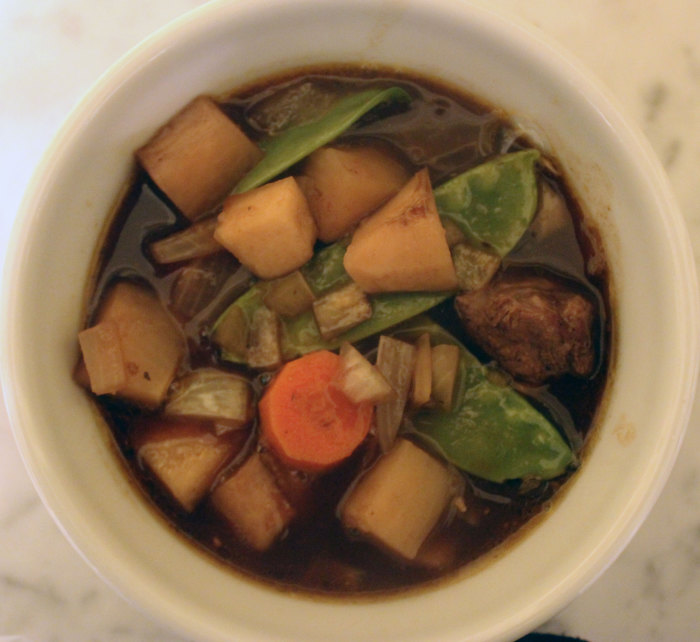I’ve been walking around Manhattan on a mission. All Christmas shopping is to be done by this Friday, November 30. A noble idea and it will fail: the elements are against me. “It’s so cold,” people say as we exchange comments on the weather. The streets are blaring with wind, the subways so cold you keep you coat buttoned. And spring is almost four months away. I’m making sure I hold on to my gloves. These are the days when you want to come home to comfort food, something hot, rich and satisfying from your nose to your toes. I posted this recipe four years ago. Suzi and I plan on trying it again this weekend. If you need more than a blanket or coat to keep you warm, this is the recipe.
Navarin. Just say the word and you know it has to be French. And it is. A navarin is traditional French ragout or stew of lamb and vegetables. The name probably comes from “navet,” the French word for turnips which is the one vegetable traditionally included.
Navarin has been a spring dish, which lamb is fresh and young. Today, we have lamb available year round and a cold winter night would welcome the aromas of a navarin slowly cooking in your oven.
The navarin taste is simple to describe: hearty and lamby. If you love lamb, you want this dish. If you hate the taste of lamb — and some do — it is time to look up a recipe for beef bourguignon. The dishes are very similar: not the priciest quality meat + veggies + broth + time.
Turnips may be “mandatory” but they do not have to be exclusive. I added some parsnips and potatoes to my version, just increasing the broth a bit to make sure everything was well covered as it cooked. Making extra stew here is fine because you can freeze leftovers for a frigid winter night. Reheated, the navarin can be eaten just the way you made it or you can serve it over rice or noodles. It’s the perfect, cold night comfort food that we all seek.
Navarin of Lamb
Yield: serves 6
Ingredients:
- ¼ cup olive oil
- 4 tablespoons butter
- 2 ¼ pounds shoulder of lamb, diced
- Salt and black pepper
- ½ cup brandy
- 2 tablespoon cornstarch
- 2 onions, sliced
- 4 carrots, diced
- 7 ounces young turnips, chopped
- 4 garlic cloves, crushed
- 1 teaspoon rosemary leaves
- 1 bay leaf
- ¼ cup sherry vinegar
- 2 tablespoons tomato puree (paste)
- 2 cups lamb stock or beef stock
- 2-5 cups snow peas, whatever density of flavor you prefer
- 1 tablespoon roughly chopped parsley, to serve as garnish [optional]
Preparation:
Preheat the oven to 350°F.
Heat the oil and butter in a large frying pan and brown the lamb in batches, seasoning well with salt and pepper. Transfer to an ovenproof casserole dish.
Discard the excess oil from the pan, then return the lamb to it and add the brandy. Place over a high heat to evaporate, then sprinkle in the cornstarch and stir to coat the lamb. Return the meat to the casserole dish and add the onions, carrots, turnips, garlic, rosemary and bay.
Put the vinegar, tomato puree and stock into a clean saucepan and bring to the boil over a high heat. Pour the liquid over the meat mixture, stir well and cover.
Bake for 1 ½ to 1 ¾ hours, until the lamb is tender, adding the snow peas 10 minutes before the end of the cooking time. Taste and adjust the seasoning if necessary, then scatter the chopped parsley over just before serving.
Source: Kevin Dundon’s Back to Basics [Mitchell Beazley, 2014]


